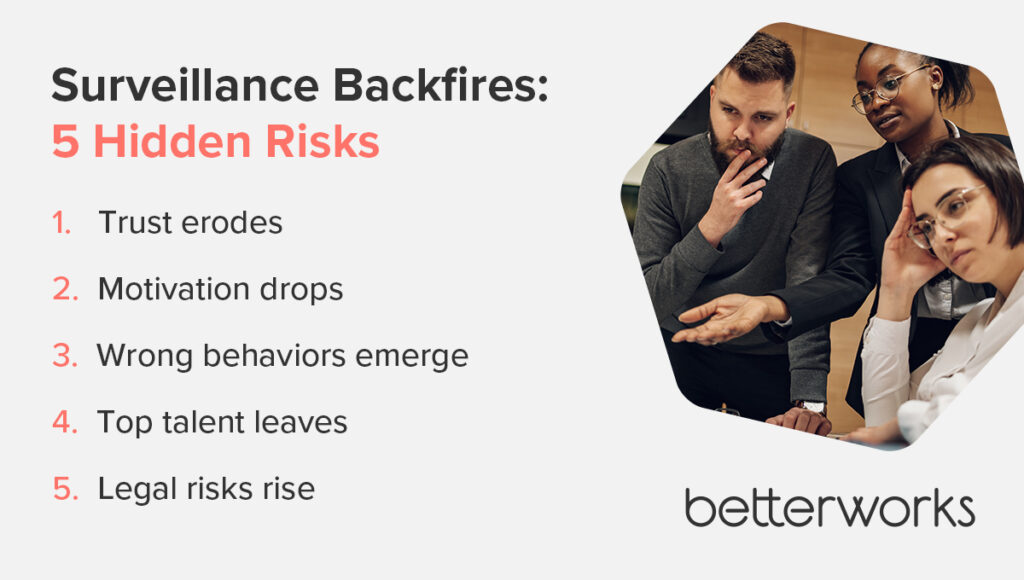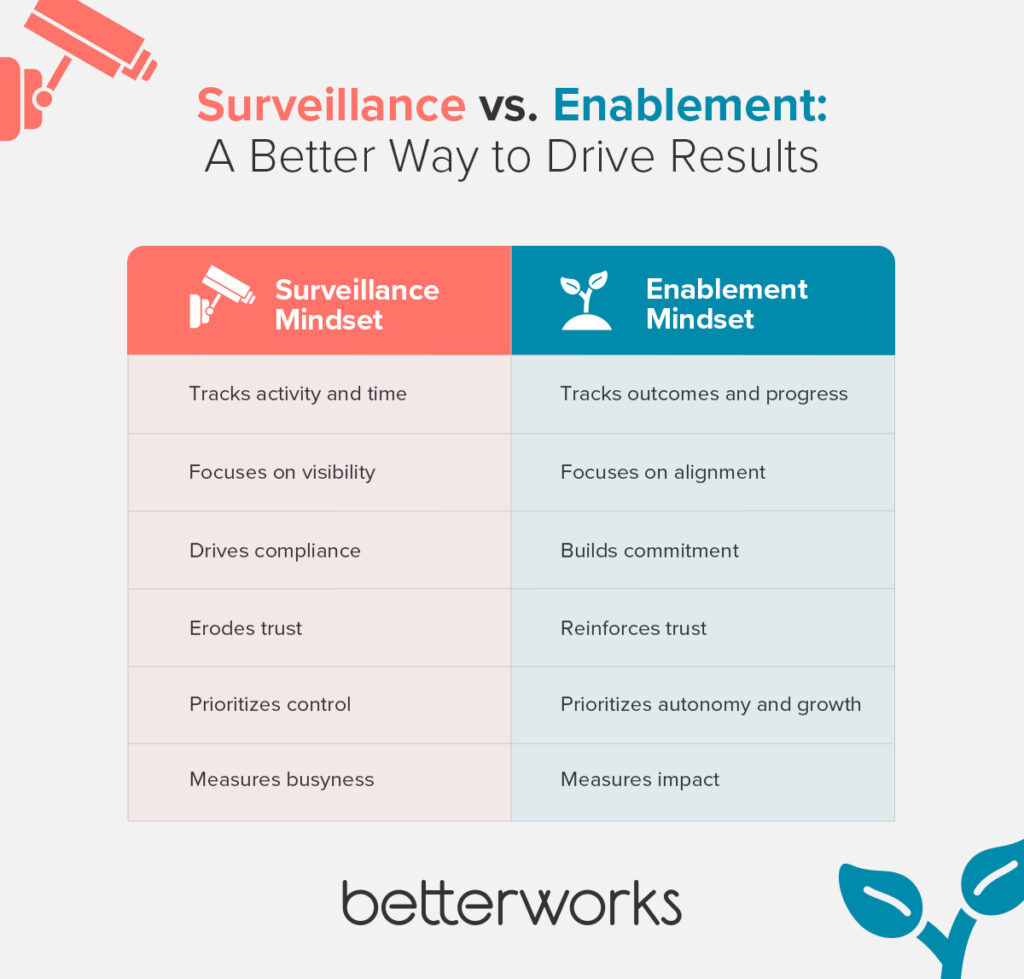- What is employee surveillance?
- Why companies monitor their employees
- What employee monitoring and surveillance don’t do
- 5 risks of employee surveillance
- When monitoring crosses the line
- What to do instead: 5 ways to enable real performance
- Empower managers to lead the shift
- If you need workplace surveillance, something’s already broken
Employee surveillance is on the rise, but there’s a good chance it’s doing more harm than good.
A recent ExpressVPN survey found that 74% of U.S. employers use online tracking tools to monitor employee activity. But instead of improving performance, employee surveillance creates a false sense of control while increasing stress levels. Employees who face online and physical monitoring report 45% higher stress levels than those in higher trust environments. And almost 25% of workers report trying to get around these tracking tools by faking productivity.
That’s not performance management. That’s performance theater.
What is employee surveillance?
Employee surveillance in the workplace refers to using digital tools to monitor, track, or record employee activity and performance data. These tools are especially common in remote and hybrid environments, where traditional oversight feels harder to maintain.
Common forms of employee surveillance include:
- Keyboard and mouse tracking
- Screen capture or screen recording
- Employee location tracking apps and time-tracking software
- Monitoring of email, Slack, or calendar activity
- Video monitoring and biometric scanners
Some employers say they’re using these tools to create accountability. Leaders want visibility into how employers spend their time and whether they’re making progress at work. But while these systems can measure activity, they rarely tell the full story and often miss what matters most.
In theory, employee surveillance helps improve performance. In practice, it tends to erode it. When employees feel their every move is being watched, they shift from focusing on impact to managing appearances. Productivity becomes performative. Trust breaks down. And any gains in oversight are quickly offset by losses in engagement and autonomy.
Surveillance isn’t neutral. It changes how people show up, what they prioritize, and how they feel about their work. And when performance culture is built on monitoring rather than meaning, it’s only a matter of time before results suffer, too. In some cases, such as disputes involving workplace privacy violations or navigating complex regulations tied to global hires, companies may even need to consult an employment based immigration lawyer to ensure compliance with labor and immigration laws while protecting both business and employee rights.

Why companies monitor their employees
Employee surveillance often intensifies during times of change. Whether it’s a shift to remote work, a companywide performance dip, or a push to bring people back to the office, monitoring is often introduced as a way to regain control. But these moves rarely address the real problem.
Return-to-office mandates, in particular, have reignited the surveillance conversation. Despite the expansion of remote and hybrid work, some leaders continue to view physical presence as a proxy for productivity. When teams push back, the response is often more employee monitoring and surveillance. But forcing visibility does not build trust or accountability.
These three arguments often come up in defense of surveillance. Here’s why each one falls short:
“We need to measure productivity.”
Surveillance may generate a lot of data, but that tells you little about the value created. Keyboard tracking and login records measure time spent, not outcomes. The appearance of activity becomes the metric, not the quality of the work or the achievement of goals. When visibility is emphasized, employees focus on keeping up appearances instead of real work.
“We don’t know what people are doing remotely.”
This objection is less about behavior and more about alignment. If leaders can’t see progress, it might mean goals aren’t clearly defined or that managers don’t have the systems in place to track real impact. Visibility gaps aren’t solved with monitoring. They’re solved with better goal-setting, feedback, and transparency.
“It’s just about accountability.”
In theory, oversight supports accountability. But in practice, high-performing employees view surveillance as a lack of trust. When accountability feels like punishment, motivation suffers. Instead of driving performance, it pushes top talent to disengage or walk away entirely.
What employee monitoring and surveillance don’t do
Surveillance can show you who logged in, how many messages were sent, or how long someone stayed online. But it can’t tell you whether customers are satisfied or if a team made the right call under pressure. It certainly can’t measure when a new hire hits their stride after weeks of feeling uncertain. It can’t show creativity and the strategic thinking that underlies successful initiatives that achieve business outcomes.
The most powerful work isn’t always trackable. A breakthrough during a quiet afternoon, an unplanned coaching moment, or the decision to hold off shipping a flawed product — these moments don’t show up in dashboards. But they are often the most crucial activities.
When organizations overrely on surface-level metrics, they risk rewarding visibility over value. That’s why modern performance strategies focus on outcomes. Busywork may create noise, but real impact comes from work that moves the business forward.
5 risks of employee surveillance
Leaders may introduce monitoring with good intentions, but the long-term impact is often counterproductive. Here are five ways surveillance can backfire while costing more than it delivers.
Breaching trust
When employees know they are being watched, they start to view their work — and their leadership — differently. Surveillance sends the message that trust must be earned rather than given, which shapes everything from collaboration to culture. Over time, this breakdown makes it harder for teams to stay engaged, aligned, and motivated.
Reducing motivation
Instead of inspiring employees to aim higher, surveillance reduces people’s desire and ability to take the initiative, think creatively, or focus on what actually moves the needle. Performance turns into compliance rather than creating impact for the team, the customer, or the mission.
Encouraging the wrong behaviors
When people feel like they are being judged on screen time or keyboard activity, they adapt, but not always in the right way. Task masking — doing what looks productive rather than what is impactful — becomes common. The focus becomes activity rather than outcomes.
Driving top performers away
High performers thrive in trust-based environments that encourage autonomy. When oversight turns into control, engagement suffers. Your top talent starts looking for another workplace where they can have more freedom and make a bigger impact.
Inviting legal and ethical risk
Employee surveillance also creates external risk, including violations of data privacy regulations or employee lawsuits. This invasive monitoring can lead to legal and reputational damage, especially when transparency is lacking or consent is unclear.

When monitoring crosses the line
The legal and reputational risks of employee surveillance in the workplace can’t be overstated. When organizations collect employee data without a clear purpose, informed consent, or appropriate safeguards, they risk violating privacy laws such as the General Data Protection Regulation and the California Consumer Privacy Act, among other employment laws and regulations.
Even where these policies are legal, overly aggressive monitoring can erode trust and raise concerns for candidates, employees, and the public. Stories of invasive tracking spread quickly, and the reputational fallout can outweigh any perceived productivity gain.
Trust plays a critical role in compliance. Organizations that responsibly handle employee data send the message that performance matters, but people come first.
What to do instead: 5 ways to enable real performance
The real question isn’t whether your people are working hard. It’s whether they know what they’re working toward—and whether they feel trusted to get there.
Surveillance may promise accountability, but it often signals that something is broken: lack of goal clarity, broken feedback loops, outdated beliefs about what drives results.
Modern teams don’t need more oversight. They need systems that clarify expectations, build alignment, and empower progress without the pressure of being constantly watched. Here’s how to create one.
Set clear, measurable goals
When employees can see what success looks like, they don’t need to be closely monitored. Shared goals, supported by fair and transparent employee performance analytics, create alignment and help teams stay focused on meaningful outcomes.
Align on outcomes, not activity
Micromanagement focuses on performative effort. Performance enablement focuses on tangible impact. Instead of tracking inputs like screen time or keystrokes, modern systems measure the employee’s progress toward outcomes that matter.
Create feedback loops that work
Ongoing check-ins, two-way feedback, and lightweight coaching help teams stay aligned without micromanagement. What employees really want from performance management is direction, support, and tangible opportunities to grow.
Enable career growth
Surveillance kills engagement. Growth fuels it. When organizations actively support employee career growth, people feel valued and empowered to take ownership of their work. That momentum leads to stronger performance, deeper engagement, and better retention.
Lead with trust over fear
Trust outperforms control, and it scales. When organizations set clear expectations and share goals, they turn trust into a performance driver. Ask employees how they want to work, and if it’s a reasonable ask, let them work that way.

Empower managers to lead the shift
Employee surveillance is often a sign of unsupported leadership. After all, most managers and leaders have good intentions. They want to connect with employees and drive performance, but without the right tools, they might feel monitoring is the only option.
That’s why manager enablement is so important. With clear goals and access to real-time performance data, managers can guide their teams more effectively. Manager coaching support helps them respond in the moment, not after the fact. They can focus less on tracking activity and more on removing blockers and reinforcing progress.
Real change starts when leaders are equipped to manage in ways that reflect how people actually work. When managers are confident in how they lead, trust grows, and performance follows.
If you need workplace surveillance, something’s already broken
When employee surveillance becomes the strategy, it usually means something else has failed. Maybe it’s alignment. Maybe it’s communication. Maybe it’s a lack of trust. Whatever the cause, surveillance is the symptom, not the solution.
High-performing organizations don’t rely on control. They build systems that make trust possible and performance visible. That’s what drives results that last.
You don’t need to track activity to know work is getting done. Real performance is measured by outcomes, not oversight.
Better performance doesn’t come from watching more. It comes from leading better.
Learn the detailed steps you can take to promote a healthy career development culture and hang on to your valued employees with our checklist, 8 Ways to Support Employee Career Growth
Promote Engagement Through Professional Growth




